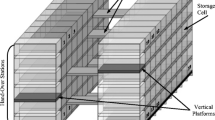Abstract
In this paper, we apply the split-platform automated storage/retrieval systems (SP-AS/RSs) (Hu et al., 2005) to store containers in the yard to improve the yard performance and to increase the utilization of the yard space. The layout of an SP-AS/RS based yard is described in detail. To achieve an efficient operation, we present a novel yard space allocation policy called the ‘second-carrier-based allocation policy’, which can help to alleviate the out-of-sequence problem of containers and the congestion of vehicles at the AS/RS racks. Different allocation policies are compared by an integrated container terminal simulation system. The simulation results show that the second-carrier-based policy is very efficient and has the potential to offer high terminal performance.
Similar content being viewed by others
References
Chen, T., 1999. Yard operations in the container terminal—unproductive moves. Marit. Policy Manag., 26(1):27–38. [doi:10.1080/030888399287041]
Chung, Y.G., Randhawa, S.U., Mcdowell, E.D., 1988. A simulation analysis for a transtainer-based container handling facility. Comput. Ind. Eng., 14(2):113–125. [doi:10.1016/0360-8352(88)90020-4]
de Castilho, B., Daganzo, C.F., 1993. Handling strategies for import containers at marine terminal. Transp. Res. Part B: Methodol., 27(2):151–166. [doi:10.1016/0191-2615(93)90005-U]
Fu, Z., Li, Y., Lim, A., Rodrigues, B., 2007. Port space allocation with a time dimension. J. Operat. Res. Soc., 58(6):797–807. [doi:10.1057/palgrave.jors.2602192]
Han, Y.B., Lee, L.H., Chew, E.P., Tan, K.C., 2008. A yard storage strategy for minimizing traffic congestion in a marine container transshipment hub. OR Spectr. [online] [doi:10.1007/s00291-008-0127-6]
Ho, H.F., Chen, R.J., 2006. Design and Simulation of a Conceptual Automated Yard Using New Combination System. Proc. Int. Joint Conf. SICE-ICASE, South Korea, p.375–380. [doi:10.1109/SICE.2006.315793]
Hu, Y.H., Huang, S.Y., Chen, C.Y., Hsu, W.J., Toh, A.C., Loh, C.K., Song, T.C., 2005. Travel time analysis of a new Automated Storage and Retrieval System. Comput. Oper. Res., 32(6):1515–1544. [doi:10.1016/j.cor.2003.11.020]
Ioannou, P.A., Kosmatopoulos, E.B., Jula, H., Collinge, A., Liu, C.I., Asef-Vaziri, A., Dougherty, E.Jr., 2002. Cargo Handling Technologies. Technical Report. Available at http://www.usc.edu/dept/ee/catt/2002/jula/Marine/FinalReport_CCDoTT_97.pdf
Kim, K.H., 1997. Evaluation of the number of rehandles in container yards. Comput. Ind. Eng., 32(4):701–711. [doi:10.1016/S0360-8352(97)00024-7]
Kim, K.H., Kim, H.B., 1999. Segregating space allocation models for containers inventories in port container terminals. Int. J. Prod. Econ., 59(1–3):415–423. [doi:10.1016/S0925-5273(98)00028-0]
Kim, K.H., Park, K.T., 2003. A note on a dynamic space-allocation method for outbound containers. Eur. J. Operat. Res., 148(1):92–101. [doi:10.1016/S0377-2217(02)00333-8]
Kim, K.H., Park, K.T., Ryu, K.R., 2000. Deriving decision rules to locate export containers in container yards. Eur. J. Operat. Res., 124(1):89–101. [doi:10.1016/S0377-2217(99)00116-2]
Liu, C.I., Jula, H., Ioannou, P.A., 2002. Design, simulation and evaluation of automated container terminals. IEEE Trans. on Intell. Transp. Syst., 3(1):12–26. [doi:10.1109/6979.994792]
McDowell, E., Cho, D., Martin, G., West, T., 1985. A Study of Maritime Container Handling. Technical Report No. 1985-003. Sea Grant College Program, Oregon State University, p.1–10.
Sarker, B.R., Babu, P.S., 1995. Travel time models in automated storage/retrieval systems: a critical review. Int. J. Prod. Econ., 40(2–3):173–184. [doi:10.1016/0925-5273(95)00075-2]
Taleb-Ibrahimi, M., de Castilho, B., Daganzo, C.F., 1993. Storage space vs. handling work in container terminals. Transp. Res. Part B: Methodol., 27(1):13–32. [doi:10.1016/0191-2615(93)90009-Y]
van den Berg, J.P., Gademann, A.J.R.M., 2000. Simulation study of an automated storage/retrieval system. Int. J. Prod. Res., 38(6):1339–1356. [doi:10.1080/002075400188889]
Watanabe, I., 1991. Characteristics and analysis method of efficiencies of container terminal—an approach to the optimal loading/unloading method. Container Age, 3:36–47.
Zhang, C.Q., Liu, J.Y., Wan, Y.W., Murty, K.G., Linn, R.J., 2003. Storage space allocation in container terminals. Transp. Res. Part B: Methodol., 37(10):883–903. [doi:10.1016/S0191-2615(02)00089-9]
Author information
Authors and Affiliations
Corresponding author
Additional information
Project supported by the Agency for Science, Technology and Research, the Maritime and Port Authority, and Nanyang Technological University, Singapore
About this article
Cite this article
Hu, Yh., Zhu, Zd. & Hsu, Wj. AS/RS based yard and yard planning. J. Zhejiang Univ. Sci. A 9, 1083–1089 (2008). https://doi.org/10.1631/jzus.A071522
Received:
Accepted:
Published:
Issue Date:
DOI: https://doi.org/10.1631/jzus.A071522




